Winter plant list
Water-Efficient Plants in January, February and March
Much of the garden is resting. Hibernating. Simplified. Winter is the time to appreciate and admire red and golden trunks, twigs, berries, and branches, as well as evergreen shrubs and trees that in other seasons provide background and structure.
Below is a list of a few of our favorite winter beauties. All of these plants can be found growing at the Fair Oaks Horticulture Center.
For more information about what’s going on at the Fair Oaks Horticulture Center, please visit Water-Efficient Landscape Gardens. To learn about the UC Davis Arboretum All-Stars, many of which can be seen at the WEL gardens, go to UC Davis Arboretum All Stars.
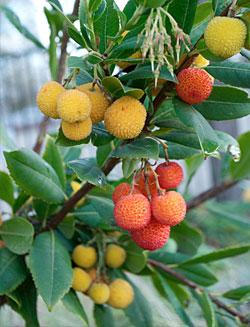
|
Arbutus unedo ‘Compacta’ Native to the coast of Ireland and along the Mediterranean coast as far as Israel, Arbutus unedo prefers dry summers. A versatile evergreen shrub or multi-trunked small tree, it tolerates a wide variety of soil types but must have good drainage to do well. Slow growing to 6 feet high and wide, this shrub will award the patient gardener with concurrent fall white blossoms and lovely berries that change from golden yellows to bright red that are set off by glossy green foliage and attractive maroon bark. Birds and bees are entranced by the buds and berries. Very drought tolerant once established and tolerant of some shade, this plant benefits from pruning that brings emphasis to the branching stems and bark. The berries are edible but tasteless. |
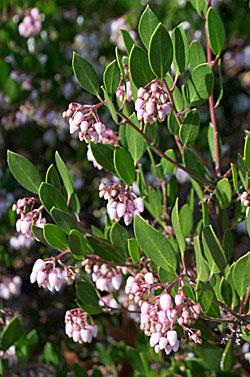
|
Arctostaphylos densiflora ‘Howard McMinn’ This durable California native, an upright shrub with handsome red bark, glossy leaves and winter blooming delicate pink blossoms, does well in the Sacramento County area. It accepts a wide variety of soils, handles pruning, can be grown in part shade, requires little summer water, and attracts hummingbirds and beneficial insects. Can grow 6 to 8 feet tall and wide. |
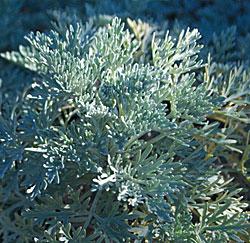
|
Artemesia x ‘Powis Castle’ This popular evergreen British hybrid perennial grows into to a silvery, lacy mound 3 feet tall and 6 feet wide. When the rest of the garden is dormant, ‘Powis Castle’ makes a bright silver statement. Flowers are insignificant. A splendid background for bright flowers of other plants, it is very tough. Provide good drainage and water two to three times a week the first year. Once established, it is drought tolerant and hardy. As the plant ages, it can become rangy and woody if not pruned to shape in fall or early spring. It also can be cut down to within 4 to 6 inches of the ground if needed to renew. |
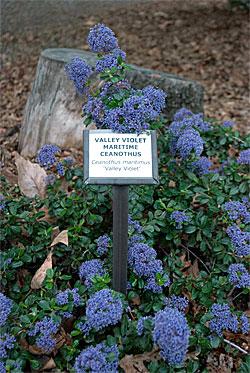
|
Ceanothus maritimus 'Valley Violet' The UC Davis Arboretum calls this low growing California native evergreen shrub “the best small ceanothus for central valley gardens.” A showstopper in winter gardens with spectacular clusters of dark-violet flowers from February to early spring that attract beneficial insects and butterflies, ‘Valley Violet' is a good choice as a groundcover for sunny and partially shady areas. Once established (which may take 2 to 3 years), it requires very little water and pruning. Tolerant of many soil types, it also is wind resistant, and heat and cold tolerant. Although we have several plants throughout the garden, it is especially lovely at the top of the perennial pathway near the scarlet oak on the edge of our native garden area (where it gets very little summer water). |
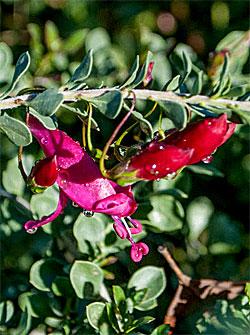
|
Eremophila maculata 'Valentine' Blooming from late fall thru spring and just in time for Valentine’s day with abundant, brilliant rose-red, inch long, tubular heart shaped flowers is the Valentine emu bush, a charming eastern Australian native evergreen that delights visitors, including hummingbirds, to the heat lab area in the Ultra-WEL garden. A mounding woody shrub that can reach 4 feet high by 5 feet, it is well suited to the low water use garden. Preferring full sun, it tolerates afternoon shade by reducing blooms. Not fussy about soil types, it does require good drainage. When not in bloom the narrow, purplish evergreen leaves make it a particularly handsome shrub which should be pruned back after blooming to prevent it from become leggy. Also, it has a reputation for being disease free. Once established it needs to be watered deeply just once or twice a month. |
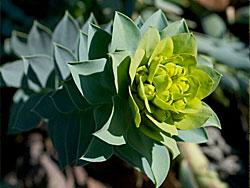
Euphorbia myrsinites
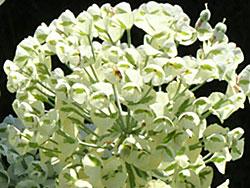
Euphorbia characias 'Tasmanian Tiger'
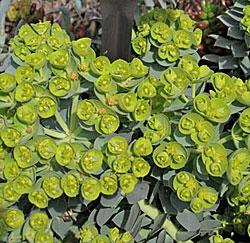
Euphorbia characias ssp. wulfenii
|
Euphorbia myrsinites Euphorbia characias Evergreen perennials that are drought, heat and cold tolerant. They love sun and well-drained soil and will be short lived if watered too much in their later years. Plants make quite a statement in the early spring landscape where the bloom can last 2 to 3 months. Size varies by variety. Donkey-tail is a ground cover reaching 12 to 18 inches high by 4 feet wide. Tasmanian Tiger makes a compact 3 feet tall by 3 feet wide shrub and ssp wulfenii grows about 3 to 5 feet high and wide. Flowers make long lasting additions to arrangements. Dip cut stems in boiling water before use as a cut flower. Prune flower stems to the ground after blooms fade to stimulate new growth from the plant base. Some varieties (ssp wulfenii and myrsinites) reseed freely. Warning: All Euphorbias have a milky sap that can irritate skin, and is toxic if ingested. Gloves should always be worn while pruning. Care should be taken in locating these plants where young children are present. |
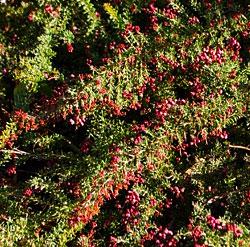
|
Grevillea lanigera 'Coastal Gem' Blooming as early as December and through winter into spring this low growing (1 foot tall by 4 feet wide), evergreen spreading shrub from Australia is extremely drought tolerant. It is also deer resistant. Sometimes known as “woolly” grevillea due to its soft, gray green leaves, it makes a good border, rock garden or ground cover plant. We have it planted on a slope (to improve drainage) at the entrance of our perennial path. Preferring full sun and neutral to slightly acidic fertile well drained soil, it can also handle some light shade in our climate. |
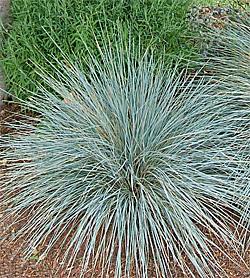
|
Helictotrichon sempervirens Blue oat grass sports spiky, steel-blue foliage. Native to the Western Mediterranean region, Helictotrichon sempervirens (hel-ik-toe-TRY-kon sem- per-VEER-enz) is a cool-season, evergreen grass that requires very little maintenance. Comb out unsightly foliage as needed and divide clumps every three years or so. Do not shear it back in late winter like you would other ornamental grasses. Planted in the front perennial garden area at the Fair Oaks Horticulture Center, our blue oat grass isn’t easily spotted from the path. The best vantage point is through the fence from the parking lot. The fountain-shaped clumps reach 2 feet in height and spread as much. Blue oat grass sends up unremarkable, straw-colored flower heads in summer. Deadhead if you feel the flower heads detract from the showy foliage. It prefers fertile, amended soil and full sun, but appreciates some late afternoon shade where summers are hottest. Good drainage is essential. Blue oat grass performs best with weekly water, but is drought tolerant and can survive on one deep watering every two weeks. For additional water conservation, adjust the irrigation schedule just enough to prevent browning during periods of extreme heat. Cater to its minimal needs and it will look fantastic year-around. Blue oat grass is deer, pest and disease resistant and often planted in perennial borders, meadow-like areas and rock gardens. Mass plantings add a dramatic effect to gardens. Companion plants include barberry, smoke bush, lavender, penstemon, nepeta, artemisia, lamb’s ear or any silver or purple-leaf plants. Grouping plants with similar water needs is always recommended. |
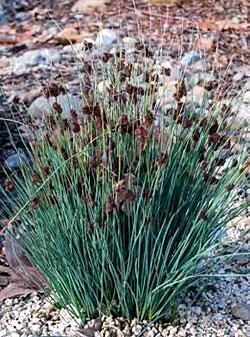
|
Juncus patens 'Carman's gray' Sited in a low spot at the entrance to the WEL native garden patio, is the evergreen perennial rush, Juncus patens ‘Carman’s gray’. Similar to ornamental grasses and sedges, rushes are distinguished by dense, cylindrical, upright rigid fine stems. Juncas patens is native to moist habitats below 5000 feet in Oregon and California where it is found along stream beds and in other moist areas. Also known as wire grass, the stiff stems were often used as foundation material in Native American baskets. Juncus patens is easy to grow and not particular about soil but prefers moist/wet areas and full sun. However it adapts well to low summer water and part shade. We have planted ours in a location where water often puddles after rains or irrigation. This is a good plant choice for rock gardens, meadows and dry streambed features. Slow growing first as a dense clump and then spreading into drifts with inconspicuous flowers it can be cut to the ground in late fall or winter to rejuvenate as needed. All cultivars are easy to grow. They are named for their stem coloring. |
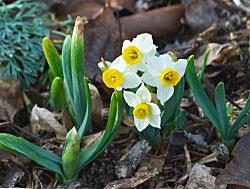
|
Narcissus canaliculatus This miniature, multi flowering, fragrant, species narcissus first introduced by the British in 1915 is easy to grow, naturalizes well and makes a lovely spring statement along the front edge of a garden bed. Many narcissus and daffodil varieties grow well and naturalize in the Sacramento area because our winter chills meet their growth requirements. However, when shopping for bulbs it is a good practice to make sure the variety is a selection for our climate, otherwise the bulbs may need to chilled and treated as an annual. Daffodils should be planted in full sun or at least in an area that receives at least 6 hours of sunlight daily. They should be planted three times the height of the bulb and will survive with very little summer water as they multiply each year. |
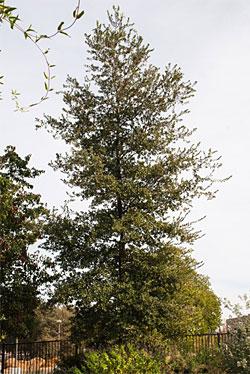
|
Quercus douglasii Midway along the Fair Oaks Horticulture Center parking lot fence is our resident blue oak. It is most likely a hybrid volunteer cached then forgotten by a scrub jay. It has been happily growing for at least 10 years. With a life expectancy of 175 to 450 years, this slow growing young potential totem could reach from 20 to 65 feet and watch over the water-efficient landscape for many years to come. Native to our foothills between 500 to 2000 feet, blue oaks are very drought tolerant. Acorns are knobby capped with smooth inside shells.Their bluish leaves can be lobed or unlobed with smooth or toothed margins. Wind pollinated, they readily hybridize with several other members of the white oak subspecies. Normally deciduous, in warmer areas foliage may linger until spring. Native habitat includes gravelly and rocky slopes and thin, well drained soils. They may go summer dormant and shed their leaves in dry years. In colder areas they exhibit fall color, but our oak isn’t especially noteworthy in the fall. In the Sacramento region they would be especially well suited for dry sites with rocky infertile soils at least 12 inches deep. For more information about growing oaks in the urban landscape see University of California Oak Woodland Management. |
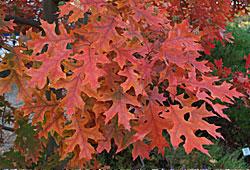
|
With brilliant golden scarlet fall foliage intensified by cool autumn nights that doesn’t drop until pushed off by new growth in the spring (a trait called marcescence) the scarlet oak is a favorite fall and winter accent plant. This attractive oak is native to the central and eastern United States where it is commonly found on sandy and gravelly upland ridges, slopes and occasionally on poorly drained soils. Growing to 80 feet tall to 50 feet wide from a youthful pyramidal shape to a mature broadly oval open crown it has been widely planted in urban areas of California as a street, parkway and lawn shade tree. Tolerant of a wide variety of soils it prefers well drained, acidic soil and is susceptible to mistletoe infestations. |
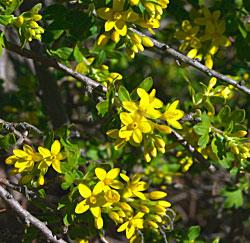
|
Ribes aureum var. gracillimum Bright green foliage and cheerful yellow clustering 1 to 1½ inch blossoms adorn this winter blooming, summer-deciduous native currant and UC Davis Arboretum All-Star. Sprawling up to 10 feet tall, the shrub naturally occurs on slopes below 2500 feet primarily in Southern California. The flowers and subsequent translucent yellow, orange, red and black berries attract birds, butterflies and beneficial insects. Preferring well drained soil, and suitable for planting under native oaks, it does well with some partial shade and light summer watering. Golden current spreads readily via rhizomes, layering stems and seedlings started from bird droppings and some pruning is needed to control the plant’s outreaching habit. It looks lovely as a companion to the concurrently blooming blue ceanothus. |
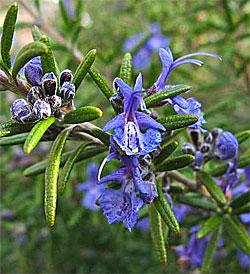
|
Salvia rosmarinus ‘Mozart,' 'Prostratus' Salvia rosmarinus 'Mozart' (common name Ed Carman's rosemary) is an evergreen shrub with dark-green leaves that are rich in aromatic oils and prized for cooking; this variety has one of the darkest blue flowers of any rosemary; blooms from late winter through summer and often again in fall; attracts beneficial insects. Considered semi-prostrate, it reaches 2’ tall and spreads to 4’ or more. |
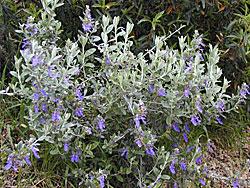
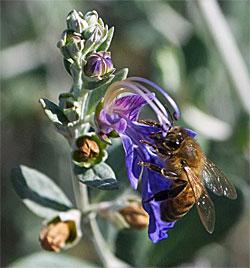
|
Teucrium fruticans 'Azureum' This UC Davis All-Star shrub starts blooming in January just in time to attract early foraging bees and other pollinators on warm days. Extremely durable, disease free and drought tolerant this western Mediterranean small shrub with gray green leaves and a long fall/ winter/spring blooming season can be pruned as a low hedge or used as an accent plant. The lovely purple/lavender blossoms attract many beneficials. |
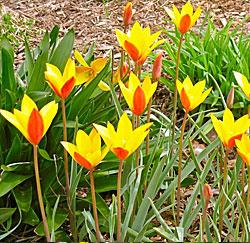
|
Tulipa clusiana 'Cynthia' Clusiana species tulips, native to Afghanistan, Iran and Iraq, are the only tulip varieties that are recommended for Mediterranean garden naturalizing in our climate zone. (We are testing that recommendation in our garden.) Growing 8 to 10 inches tall, they are among the first bulbs to bloom in early spring. These bulbs should be planted in the fall at a depth equal to three times in their diameter and 2 feet apart. After spring blooming they should be fertilized and the foliage allowed to mature and die. Bulbs should not be disturbed the rest of the year. Bulbs may be difficult to find locally. The best sources are catalogs from specialty nurseries. A good overall bulb reference is the Pacific Bulb Society. |



